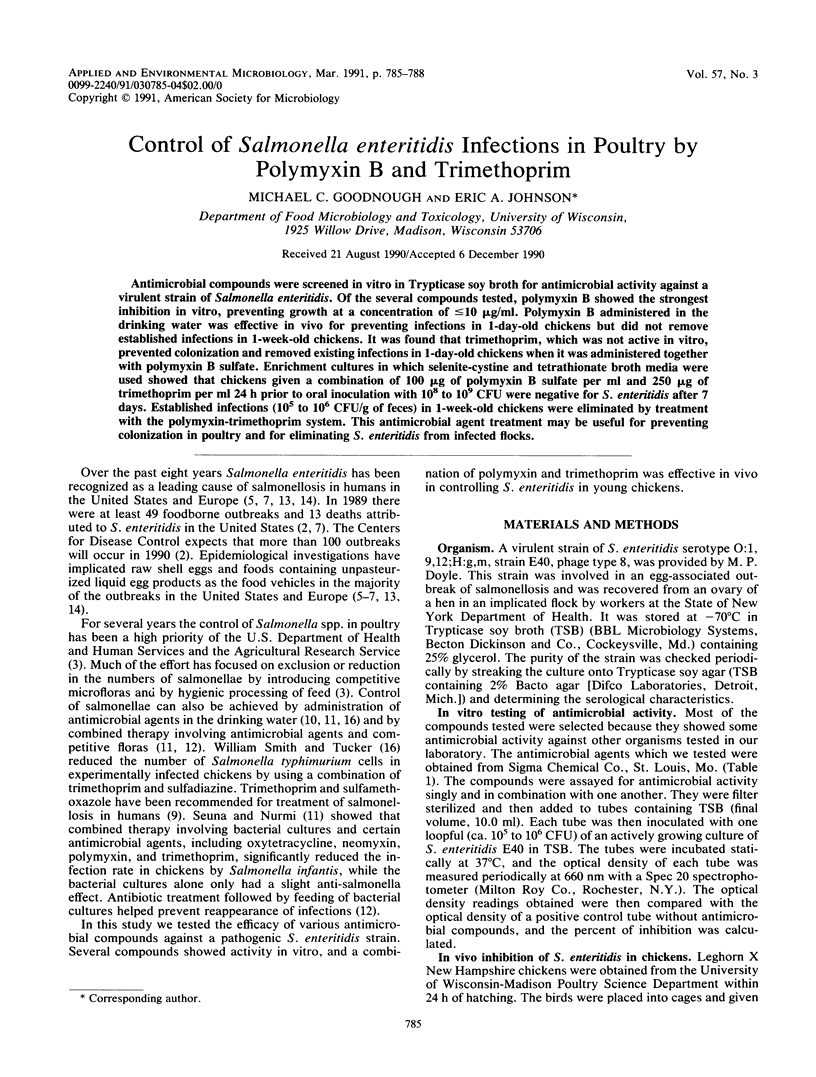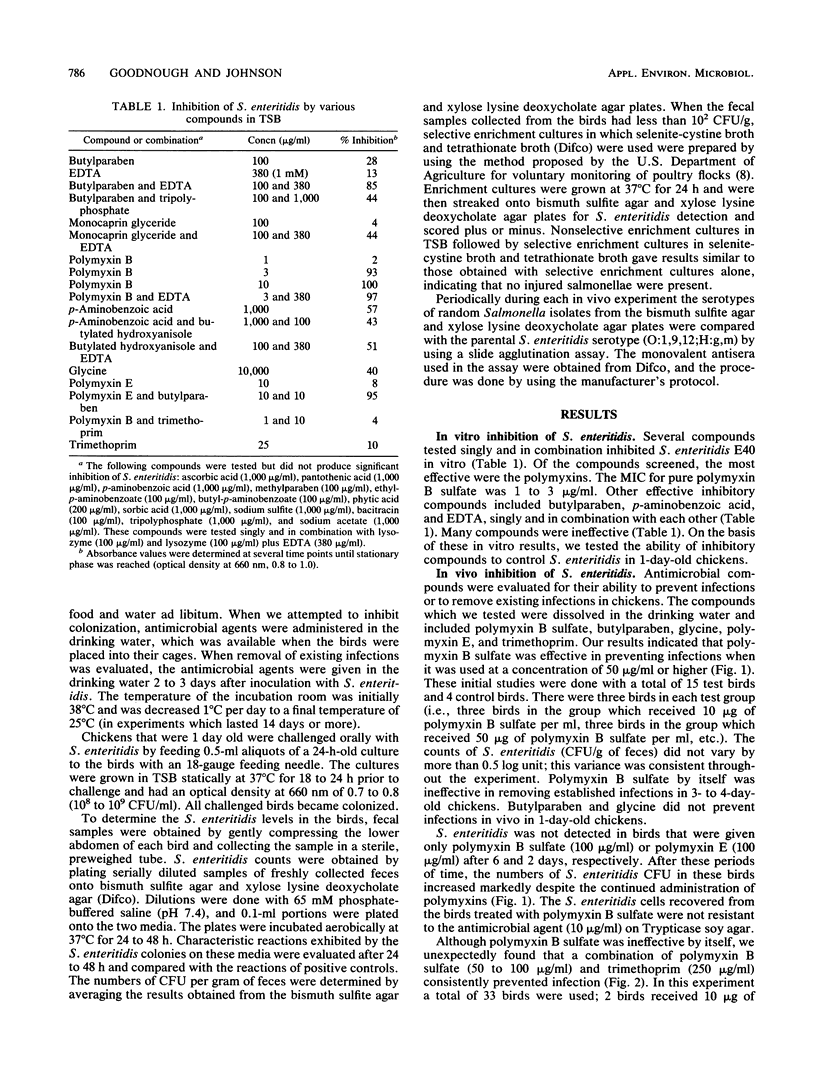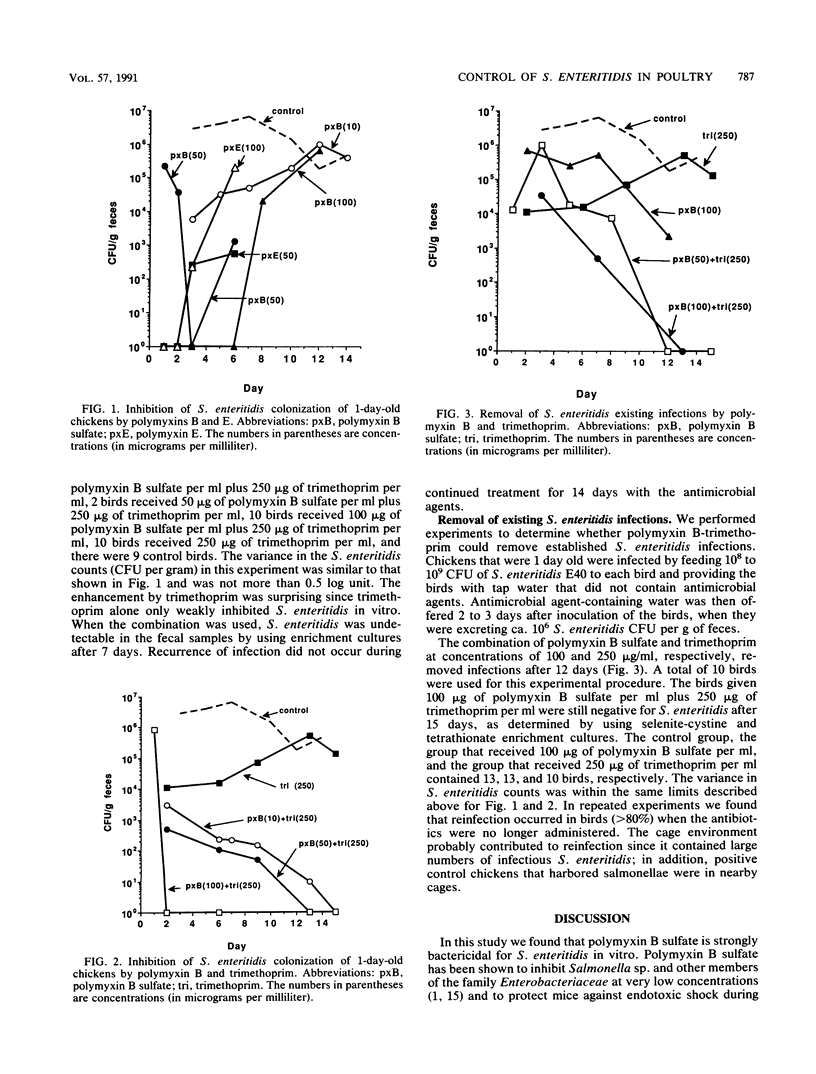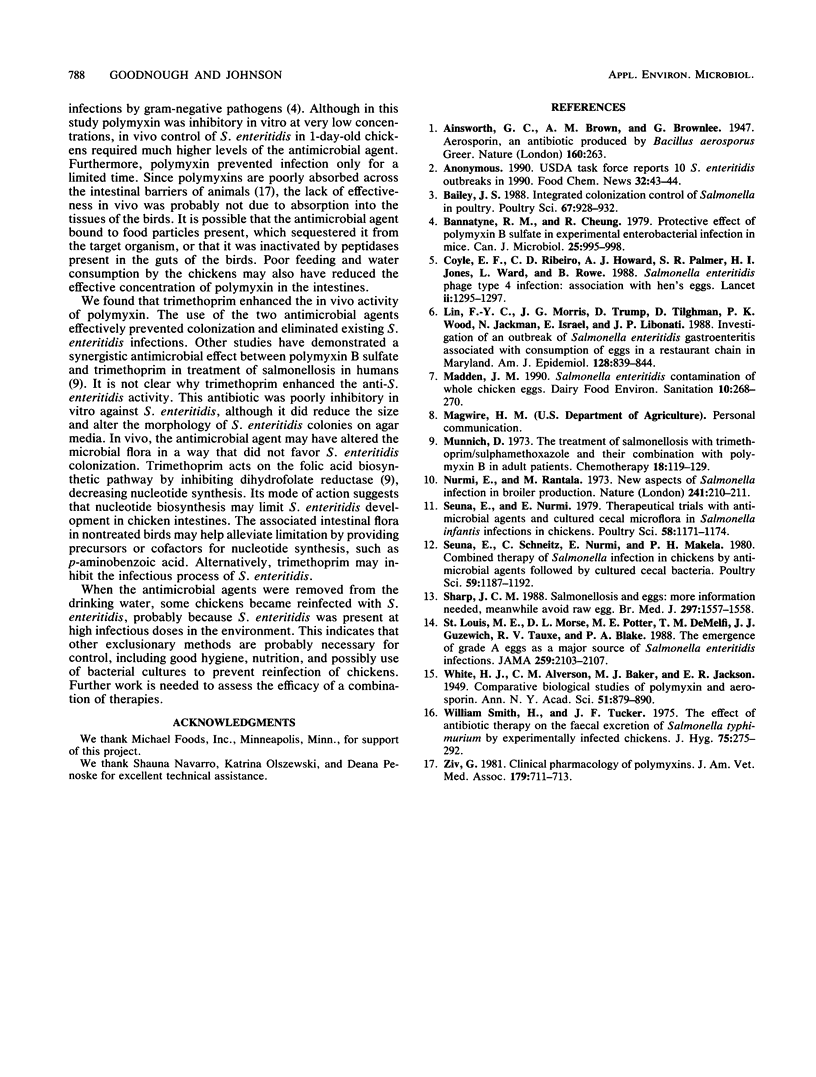Abstract
Antimicrobial compounds were screened in vitro in Trypticase soy broth for antimicrobial activity against a virulent strain of Salmonella enteritidis. Of the several compounds tested, polymyxin B showed the strongest inhibition in vitro, preventing growth at a concentration of less than or equal to 10 micrograms/ml. Polymyxin B administered in the drinking water was effective in vivo for preventing infections in 1-day-old chickens but did not remove established infections in 1-week-old chickens. It was found that trimethoprim, which was not active in vitro, prevented colonization and removed existing infections in 1-day-old chickens when it was administered together with polymyxin B sulfate. Enrichment cultures in which selenite-cystine and tetrathionate broth media were used showed that chickens given a combination of 100 micrograms of polymyxin B sulfate per ml and 250 micrograms of trimethoprim per ml 24 h prior to oral inoculation with 10(8) to 10(9) CFU were negative for S. enteritidis after 7 days. Established infections (10(5) to 10(6) CFU/g of feces) in 1-week-old chickens were eliminated by treatment with the polymyxin-trimethoprim system. This antimicrobial agent treatment may be useful for preventing colonization in poultry and for eliminating S. enteritidis from infected flocks.
Full text
PDF



Selected References
These references are in PubMed. This may not be the complete list of references from this article.
- Bailey J. S. Integrated colonization control of Salmonella in poultry. Poult Sci. 1988 Jun;67(6):928–932. doi: 10.3382/ps.0670928. [DOI] [PubMed] [Google Scholar]
- Bannatyne R. M., Cheung R. Protective effect of polymyxin B sulfate in experimental enterobacterial infection in mice. Can J Microbiol. 1979 Sep;25(9):995–998. doi: 10.1139/m79-153. [DOI] [PubMed] [Google Scholar]
- Coyle E. F., Palmer S. R., Ribeiro C. D., Jones H. I., Howard A. J., Ward L., Rowe B. Salmonella enteritidis phage type 4 infection: association with hen's eggs. Lancet. 1988 Dec 3;2(8623):1295–1297. doi: 10.1016/s0140-6736(88)92902-9. [DOI] [PubMed] [Google Scholar]
- Lin F. Y., Morris J. G., Jr, Trump D., Tilghman D., Wood P. K., Jackman N., Israel E., Libonati J. P. Investigation of an outbreak of Salmonella enteritidis gastroenteritis associated with consumption of eggs in a restaurant chain in Maryland. Am J Epidemiol. 1988 Oct;128(4):839–844. doi: 10.1093/oxfordjournals.aje.a115037. [DOI] [PubMed] [Google Scholar]
- Münnich D. The treatment of salmonellosis with trimethoprim-sulphamethoxazole and their combination with polymyxin B in adult patients. Chemotherapy. 1973;18(2):119–129. doi: 10.1159/000221253. [DOI] [PubMed] [Google Scholar]
- Nurmi E., Rantala M. New aspects of Salmonella infection in broiler production. Nature. 1973 Jan 19;241(5386):210–211. doi: 10.1038/241210a0. [DOI] [PubMed] [Google Scholar]
- Seuna E., Nurmi E. Therapeutical trials with antimicrobial agents and cultured cecal microflora in Salmonella infantis infections in chickens. Poult Sci. 1979 Sep;58(5):1171–1174. doi: 10.3382/ps.0581171. [DOI] [PubMed] [Google Scholar]
- Seuna E., Schneitz C., Nurmi E. Combined therapy of Salmonella infection in chickens by antimicrobial agents followed by cultured cecal bacteria. Poult Sci. 1980 Jun;59(6):1187–1192. doi: 10.3382/ps.0591187. [DOI] [PubMed] [Google Scholar]
- Sharp J. C. Salmonellosis and eggs. BMJ. 1988 Dec 17;297(6663):1557–1558. doi: 10.1136/bmj.297.6663.1557. [DOI] [PMC free article] [PubMed] [Google Scholar]
- Smith H. W., Tucker J. F. The effect of antibiotic therapy on the faecal excretion of Salmonella typhimurium by experimentally infected chickens. J Hyg (Lond) 1975 Oct;75(2):275–292. doi: 10.1017/s0022172400047306. [DOI] [PMC free article] [PubMed] [Google Scholar]
- St Louis M. E., Morse D. L., Potter M. E., DeMelfi T. M., Guzewich J. J., Tauxe R. V., Blake P. A. The emergence of grade A eggs as a major source of Salmonella enteritidis infections. New implications for the control of salmonellosis. JAMA. 1988 Apr 8;259(14):2103–2107. [PubMed] [Google Scholar]
- Ziv G. Clinical pharmacology of polymyxins. J Am Vet Med Assoc. 1981 Oct 1;179(7):711–713. [PubMed] [Google Scholar]


